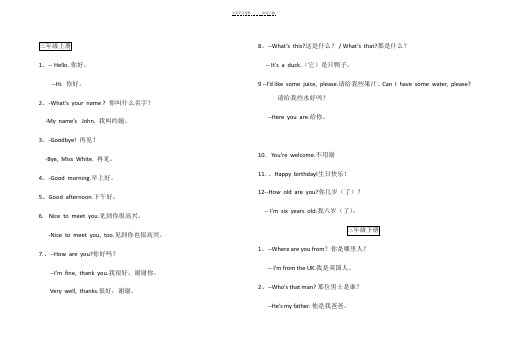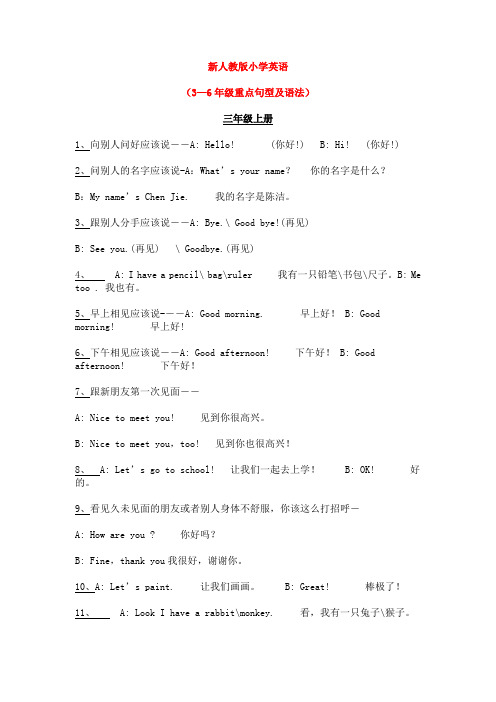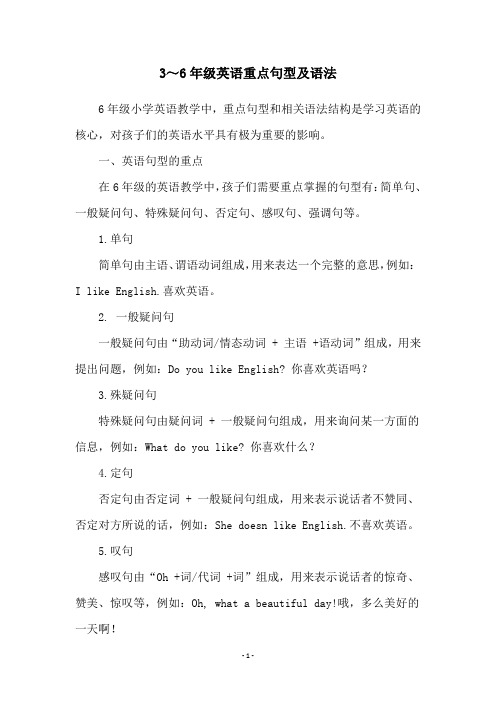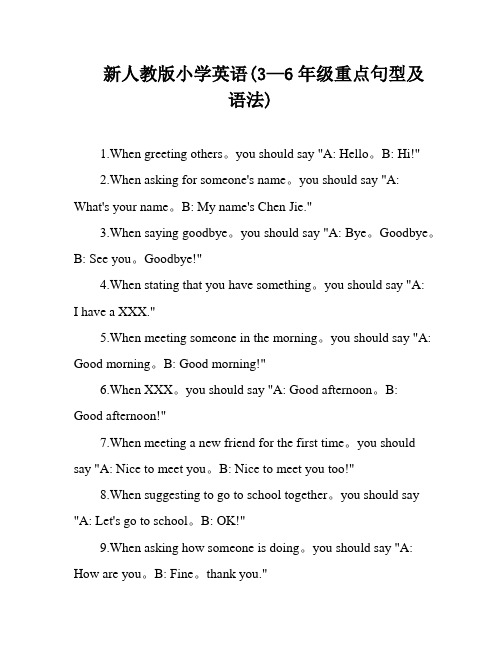2016年小学新人教版英语(3—6年级重点句型及语法)
人教版英语(3—6年级)重点句型及语法归纳

人教版英语(3—6年级)重点句型及语法归纳六年级上册重点词汇、句型、语法总复习。
Unit 1by( ) foot( ) bike( ) bus( ) train( ) how( ) go to school()traffic() traffic light() traffic rule()stop() wait() get to() by plane( ) by ship ( ) by subway( )Unit 2library( ) post office( ) hospital( ) cinema( ) bookstore()turn( ) then( ) where( ) please( ) next to( ) turn right ( ) turn left( ) go straight( )north( ) south( ) east( ) west( )Unit 3next week( ) this morning( ) this afternoon( ) this ) comic book( ) post card( ) newspaper( ) buy( )Unit 4hobby( ) ride a bike—riding a bike( the violin—playing the violin( ) dive—diving( ) make kites— )collect stamps—collecting stamps ( ) live—lives( ) teach—teaches( ) go—goes( ) watch—watches( ) read—reads( ) does( ) doesn’ )Unit 5 X Kb1 .C omsinger( ) writer( ) actor( ) actress( ) artist( )policeman( ) cleaner( ) work()Unit 6cloud ( ) sun( ) come from( ) seed( ) soil( ) sprout( ) plant( ) then( )a pair of()always()dictionary()tomorrow()excuse me () fun() go to the cinema()look(()read a magazine()science museum()shoe store() take() take a trip() tell() tonight() vapor ())with() know() minute() again ( )重点句型Unit 1How do you go to school, Sarah? 萨拉,你怎样去上学?Usually I go to school on foot. 通常我步行去上学。
人教版小学英语三至六年级重点句型

1、-- Hello. 你好。
--Hi. 你好。
2、-What’s your name ? 你叫什么名字?-My name’s John. 我叫约翰。
3、-Goodbye! 再见!-Bye, Miss White. 再见。
4、-Good morning.早上好。
5、Good afternoon.下午好。
6.Nice to meet you.见到你很高兴。
-Nice to meet you, too.见到你也很高兴。
7.、--How are you?你好吗?--I’m fine, thank you.我很好,谢谢你。
Very well, thanks.很好,谢谢。
8、--What’s this?这是什么? / What’s that?那是什么?-- It’s a duck.(它)是只鸭子。
9 --I’d like some juice, please.请给我些果汁。
Can I have some water, please?请给我些水好吗?--Here you are.给你。
10.You’re welcome.不用谢11.、Happy birthday!生日快乐!12--How old are you?你几岁(了)?-- I’m six years old.我六岁(了)。
1、--Where are you from?你是哪里人?-- I’m from the UK.我是英国人。
2、--Who’s that man? 那位男士是谁?--He’s my father. 他是我爸爸。
3、--Who’s that woman? 那位女士是谁?--She’s my mother. 她是我妈妈。
4、--Is she your mother? 她是你的妈妈吗?--Yes, she is. 是的,她是。
5、--Is he your father? 他是你的爸爸吗?--No, he isn’t. 不,他不是。
6、--Where is my pencil box? 我的铅笔盒在哪里?--It’s in your desk.在你桌子里。
最新人教版小学英语(3—6年级重点句型及语法)

新人教版小学英语(3—6年级重点句型及语法)三年级上册1、向别人问好应该说――A: Hello! (你好!) B: Hi! (你好!)2、问别人的名字应该说-A:What’s your name?你的名字是什么?B:My name’s Chen Jie. 我的名字是陈洁。
3、跟别人分手应该说――A: Bye.\ Good bye!(再见)B: See you.(再见) \ Goodbye.(再见)4、A: I have a pencil\ bag\ruler 我有一只铅笔\书包\尺子。
B: Me too . 我也有。
5、早上相见应该说-――A: Good morning. 早上好! B: Goodmorning! 早上好!6、下午相见应该说――A: Good afternoon! 下午好! B: Good afternoon! 下午好!7、跟新朋友第一次见面――A: Nice to meet you! 见到你很高兴。
B: Nice to meet you,too! 见到你也很高兴!8、A: Let’s go to school! 让我们一起去上学!B: OK! 好的。
9、看见久未见面的朋友或者别人身体不舒服,你该这么打招呼-A: How are you ? 你好吗?B: Fine,thank you我很好,谢谢你。
10、A: Let’s paint. 让我们画画。
B: Great! 棒极了!11、A: Look I have a rabbit\monkey. 看,我有一只兔子\猴子。
B: Cool\Super \ Great \ Wow! 酷\超级好\棒极了\好厉害.12、你想看下别人的东西,你该这么说――A: May I have a look? 我可以看一看吗?B: Sure. Here you are! 当然可以。
给你!13、请别人吃东西,你该这么说――A: Have some French fries. 吃一些炸薯条。
人教版小学英语三至六年级重点句型

三年级上册1、-- Hello. 你好。
--Hi. 你好。
2、-What’s your name ? 你叫什么名字?-My name’s John. 我叫约翰。
3、-Goodbye! 再见!-Bye, Miss White. 再见。
4、-Good morning.早上好。
5、Good afternoon.下午好。
6.Nice to meet you.见到你很高兴。
-Nice to meet you, too.见到你也很高兴。
7.、--How are you?你好吗?--I’m fine, thank you.我很好,谢谢你。
Very well, thanks.很好,谢谢。
8、--What’s this?这是什么? / What’s that?那是什么?-- It’s a duck.(它)是只鸭子。
9 --I’d like some juice, please.请给我些果汁。
Can I have some water, please?请给我些水好吗?--Here you are.给你。
10.You’re welcome.不用谢11.、Happy birthday!生日快乐!12--How old are you?你几岁(了)?-- I’m six years old.我六岁(了)。
三年级下册1、--Where are you from?你是哪里人?-- I’m from the UK.我是英国人。
2、--Who’s that man? 那位男士是谁?--He’s my father. 他是我爸爸。
3、--Who’s that woman? 那位女士是谁?--She’s my mother. 她是我妈妈。
4、--Is she your mother? 她是你的妈妈吗?--Yes, she is. 是的,她是。
5、--Is he your father? 他是你的爸爸吗?--No, he isn’t. 不,他不是。
3~6年级英语重点句型及语法

3~6年级英语重点句型及语法6年级小学英语教学中,重点句型和相关语法结构是学习英语的核心,对孩子们的英语水平具有极为重要的影响。
一、英语句型的重点在6年级的英语教学中,孩子们需要重点掌握的句型有:简单句、一般疑问句、特殊疑问句、否定句、感叹句、强调句等。
1.单句简单句由主语、谓语动词组成,用来表达一个完整的意思,例如:I like English.喜欢英语。
2. 一般疑问句一般疑问句由“助动词/情态动词 + 主语 +语动词”组成,用来提出问题,例如:Do you like English? 你喜欢英语吗?3.殊疑问句特殊疑问句由疑问词 + 一般疑问句组成,用来询问某一方面的信息,例如:What do you like? 你喜欢什么?4.定句否定句由否定词 + 一般疑问句组成,用来表示说话者不赞同、否定对方所说的话,例如:She doesn like English.不喜欢英语。
5.叹句感叹句由“Oh +词/代词 +词”组成,用来表示说话者的惊奇、赞美、惊叹等,例如:Oh, what a beautiful day!哦,多么美好的一天啊!6.调句强调句由“It is/was +强调部分 + that/who + 主句”组成,用来强调句子成分,例如:It is I who like English.我喜欢英语。
二、英语语法的重点6年级学生还需要掌握英语语法中的各类词类、时态、句子结构等:1.类词类学生们需要掌握单词、介词、动词、形容词、副词、代词、连词、冠词等英语语法的各类词类,以及其用法。
2.昀学生们要掌握现在时、过去时、将来时等不同时态的表达,了解它们的基本用法及区别。
3.子结构学生们要熟悉句子的简单结构、复合句的构成及连接词,能正确使用并分析句子。
三、综合练习在6年级学习英语时,综合练习也很重要,学生们可以利用实际情景,练习用英语表达句子,并能在日常对话中正确运用。
练习的方法可以是旁听英语对话,分析句子结构,以及反复练习句型,多种形式的练习将更容易帮助孩子们熟练掌握句型和语法。
新人教版小学英语(3—6年级重点句型及语法)

1小学英语三年级至六年级重点句型及语法三年级上册1、向别人问好应该说――A: Hello! (你好!) B: Hi! (你好!)2、问别人的名字应该说-A:What’s your name?你的名字是什么?B:My name’s Chen Jie. 我的名字是陈洁。
3、跟别人分手应该说――A: Bye.\ Good bye!(再见)B: See you.(再见) \ Goodbye.(再见)4、A: I have a pencil\ bag\ruler 我有一只铅笔\书包\尺子。
B: Me too . 我也有。
5、早上相见应该说-――A: Good morning. 早上好!B: Good morning! 早上好!6、下午相见应该说――A: Good afternoon! 下午好!B: Good afternoon! 下午好!7、跟新朋友第一次见面――A: Nice to meet you! 见到你很高兴。
B: Nice to meet you,too! 见到你也很高兴!8、A: Let’s go to school! 让我们一起去上学!B: OK! 好的。
9、看见久未见面的朋友或者别人身体不舒服,你该这么打招呼-A: How are you ? 你好吗?B: Fine,thank you我很好,谢谢你。
10、A: Let’s paint. 让我们画画。
B: Great! 棒极了!11、A: Look I have a rabbit\monkey. 看,我有一只兔子\猴子。
B: Cool\Super \ Great \ Wow! 酷\超级好\棒极了\好厉害.12、你想看下别人的东西,你该这么说――A: May I have a look? 我可以看一看吗?。
新人教版小学英语(3—6年级重点句型及语法)

新人教版小学英语(3—6年级重点句型及语法)1.When greeting others。
you should say "A: Hello。
B: Hi!"2.When asking for someone's name。
you should say "A:What's your name。
B: My name's Chen Jie."3.When saying goodbye。
you should say "A: Bye。
Goodbye。
B: See you。
Goodbye!"4.When stating that you have something。
you should say "A:I have a XXX."5.When meeting someone in the morning。
you should say "A: Good morning。
B: Good morning!"6.When XXX。
you should say "A: Good afternoon。
B:Good afternoon!"7.When meeting a new friend for the first time。
you should say "A: Nice to meet you。
B: Nice to meet you too!"8.When suggesting to go to school together。
you should say "A: Let's go to school。
B: OK!"9.When asking how someone is doing。
you should say "A: How are you。
3到6年级英语重点句型及语法

重点句型:1.、What a nice present!多好的礼物啊!【解析】此句为感叹句,感叹句是用来表示说话人强烈的情绪的句子,多用how和what引起,其基本句型为:“What+名词+主语+谓语”和“How+形容词+主语+谓语”。
两者可互换。
2.、Don't go outside!不要到外面去!【解析】此句是一个祈使句。
祈使句可用来表示请求,命令,建议,邀请,禁止等。
3.、When I was young,I couldn't play with candles. I couldn't cook,either.当我小的时候,我不能玩蜡烛,也不能做饭。
【解析】play with意为“玩耍”。
play with fire玩火;play with balls玩球。
【辨析】either意为“也”,放在否定句句末。
too,also都表示“也”的意思,too放肯定句句末或疑问句中。
also常用于肯定句中,放在be动词后面,行为动词前面。
重点语法:动词加-s或-es方法歌诀:动词三单现在式,一般词尾加-s。
s, x, ch, sh在词尾,直接加上-es。
词尾若是字母o,加上-es不用愁。
“辅音字母+y“来结尾,变y为i是正规。
-es后边紧跟随,study→studies看明白。
“be going to”的用法口诀:be going to, 表打算,准备、计划将干。
表可能,有必然,通过现象来推断。
使用它,要注意,疑问形式be提前。
否定句,更简单,not放在be后边。
to之后,动原形,be的形式看人称。
下列词,要注意,come go和离去进行时,表将来,牢牢记住莫忘记。
英语复习:复习所有在课本里的必备词汇,在复习的时候,不仅之复习词汇,你还要对这些词汇所组成的词组也要做一个系统的联想性的复习。
复习课本的里的英语阅读资料,因为在很多期末考试中,原有课文的阅读资料都会有一定的占比。
并且这样的占比还不是很小。
- 1、下载文档前请自行甄别文档内容的完整性,平台不提供额外的编辑、内容补充、找答案等附加服务。
- 2、"仅部分预览"的文档,不可在线预览部分如存在完整性等问题,可反馈申请退款(可完整预览的文档不适用该条件!)。
- 3、如文档侵犯您的权益,请联系客服反馈,我们会尽快为您处理(人工客服工作时间:9:00-18:30)。
2016年新人教版小学英语(3—6年级重点句型及语法)三年级上册1、向别人问好应该说――A: Hello! (你好!) B: Hi! (你好!)2、问别人的名字应该说-A:What’s your name?你的名字是什么?B:My name’s Chen Jie. 我的名字是陈洁。
3、跟别人分手应该说――A: Bye.\ Good bye!(再见)B: See you.(再见) \ Goodbye.(再见)4、 A: I have a pencil\ bag\ruler 我有一只铅笔\书包\尺子。
B: Me too . 我也有。
5、早上相见应该说-――A: Good morning. 早上好! B: Good morning! 早上好!6、下午相见应该说――A: Good afternoon! 下午好! B: Good afternoon! 下午好!7、跟新朋友第一次见面――A: Nice to meet you! 见到你很高兴。
B: Nice to meet you,too! 见到你也很高兴!8、A: Let’s go to school! 让我们一起去上学! B: OK! 好的。
9、看见久未见面的朋友或者别人身体不舒服,你该这么打招呼-A: How are you ? 你好吗?B: Fine,thank you我很好,谢谢你。
10、A: Let’s paint. 让我们画画。
B: Great! 棒极了!11、 A: Look I have a rabbit\monkey. 看,我有一只兔子\猴子。
B: Cool\Super \ Great \ Wow! 酷\超级好\棒极了\好厉害.12、你想看下别人的东西,你该这么说――A: May I have a look? 我可以看一看吗?B: Sure. Here you are! 当然可以。
给你!13、请别人吃东西,你该这么说――A: Have some French fries. 吃一些炸薯条。
B: Thank you.\ No, thanks. 谢谢你。
\不,谢谢你。
14、A: What do you like? 你喜欢什么?B: I like hot dogs. 我喜欢热狗。
15、你想吃点东西,你该说――A: Can I have some chicken?我能吃一些鸡肉?B: Sure here you are. 当然可以,给你。
16、A: Thank you. 谢谢你。
B: You're welcome. 别客气。
17、A:B: Happy birthday. 生日快乐!B: Thank you. 谢谢。
18、A: How old are you? 你几岁啦?B: I’m nine. 我九岁了。
(要用数字回答哦!)19、A: Let's eat the birthday cake. 让我们吃生日蛋糕B: Great! 棒极了!20、A: How many balloons\ gifts? 多少个气球\礼物?B: Four \ ten. 四/十。
三年级下册Unit 11、Hi! /Hello! 你好!——用于比较熟悉的人打招呼2、I’m Amy. 我叫埃米。
——用于自我介绍3、Where are you from? 你来自哪里? ——用于问别人是哪儿人时I’m from the UK/ America /Canada /China. 我来自英国/美国/加拿大/中国。
——用于介绍来自哪个国家4、Welcome !欢迎Unit 21、Who’s that woman? 那个女人是谁?She’s my mother. 她是我的妈妈。
2、Who’s that man? 那个男人是谁?He’s my father. 他是我的爸爸。
3、Is she your sister? 她是你的妹妹吗?Yes,she is.\No ,she isn’t. 是的,她是。
\不,她不是。
4、Is he your brother? 他是你的弟弟吗?Yes, he is. \ No, he isn’t. 是的,他是。
\不,他不是。
5、This is my family. 这是我的家庭。
Unit 31、Wow ! It’s so big. /It’s so tall ! 哇!它是如此的大。
/它好高啊!2、Come here , children . 到这里来,孩子们。
3、It has a long nose . 它有长鼻子。
4、It has small eyes and big ears . 它有小眼睛和大耳朵。
Unit 41、Mom, where is my car ? 妈妈,我的小汽车在哪里?On your desk ? 在你的课桌上吗?In the toy box ? 在你的玩具箱里吗?It’s under the chair. 它在那把椅子下面。
2、Silly me ! 我真傻!3、Is it in your bag ? 在你的包里吗? No, it isn ’t./Yes, it is. 不,不在。
/是的,在。
4、Who are you? I’m … 你是谁? 我是…… ——用于询问别人的名字5、What’t in your box? 你的盒子里是什么? ——用于询问盒子里有什么物品Unit 51、 Do you like peaches? 你喜欢桃吗?Yes, I do./ No, I don’t. 是的,我喜欢。
/ 不,我不喜欢。
2、 What about pears? 梨怎么样? I like them very much. 我非常喜欢它们。
Sorry , I don ’t like grapes . 抱歉,我不喜欢葡萄。
Me ,neither. 我也不喜欢。
3、 A: Can I have an apple , please? 请问我能吃一个苹果吗?Can I have a watermelon , please? 请问我能吃一个西瓜吗?Can I have some orange juice , please? 请问我能喝一些橙汁吗? B: Certainly./ Sure. Here you are. 当然可以。
/当然可以。
给你。
4、 Have some more ? No , thank you. 再吃一些吧? 不,谢谢。
Unit 6 1、How many kites do you see? 你能看到多少只风筝呀?I can see 12. 我能看到十二只。
2、How many crayons do you have? 你有多少支蜡笔?I have 16. 我有十六支蜡笔。
3、The black one is a bird. 那个黑色的是一只鸟。
4、Look at my new crayons! 看我的新蜡笔!——用于询问人物之间关系 用于询问别人某物在哪里 用于问别人是否喜欢吃某种水果用于请示别人是否可以吃某食物 ——用于问有多少什么东西5、Oh, how nice! 噢,真漂亮!6、Open it and see! 打开它看看!7、That’s right! 答对了!8、Let’s pick up the apples. 让我们摘苹果吧!Let’s have a race. 让我们来比赛吧!9、Good idea ! 好主意!Recycle 21、I’m tall. I can get the apples. 我很高。
我能摘到苹果。
2、I’m strong. I can carry the fruit. 我很强壮。
我能运送水果。
3、Let’s count. 让我们数数吧。
4、Look ! It’s there / here. 看!它在那里/ 这里。
【缩写】完整形式缩写形式完整形式缩写形式完整形式缩写形式I am I’m we are we’re is not isn’tthey are they’re you are you’re are not aren’tshe is she’s there are there’re has not hasn’the is he’s what is what’s have not haven’tit is it’s who is who’s can not can’tTom is Tom’s where is where’sthat is that’s there is there’s【基础必背】四年级上册Unit 11 What’s in the classroom ?教室里有什么?2 We have 6 new lights .我们有六盏新灯。
3 This is Zhang Peng .这是张鹏。
4 It’s so big !好大呀!5 Where’s my seat ?It’s near the door .我的座位在哪里?在们的旁边。
6 Let’s clean the classroom.让我们打扫教室吧。
7 Let me clean the window .让我擦窗户吧。
8 All right !好的!9 Look at the picture .看这幅图。
10 Good idea !好主意!11 Good job !干得好!12 There is a bee in our classroom .我们教室里有一只蜜蜂。
13 Where is it ?它在哪里?14 It’s on the fan.它在风扇上。
15 We have a new classroom.我们有一个新教室。
16 Where’s my sharpener ? It’s near the fish bowl .我的卷笔刀在哪?它在鱼缸的旁边。
17 Help !救命!18 Open the door .开门。
19 Turn on the light .开灯!20 Sweep the floor .扫地。
21 Clean the window .擦窗户。
22 Put up the picture .挂图片。
23 Clean the board .擦黑板(blackboard ,green board , white board)24 Really ?Let’s go and have a look .真的吗?让我们去看一看。
25 every day:每天26 have fun:有趣27 Look !This is my classroom.The wall is white .The floor is green…看!这是我的教室。
墙是白的。
门是绿的。
